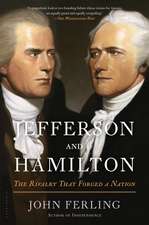First Ladies and the Fourth Estate: Press Framing of Presidential Wives
Autor Lisa M. Burnsen Limba Engleză Hardback – 23 iul 2008
Through press coverage, U.S. first ladies have become some of the most prominent and recognized figures in American politics. While the U.S. Constitution doesn’t enumerate the responsibilities of the first lady, a succession of dynamic women, beginning with Martha Washington, have shaped this post into a highly visible public office. First ladies have performed a variety of public and private roles, from hostess, escort, and social advocate to advisor and policymaker. The gendered nature of the position, however, has always influenced first ladies’ performance as they balanced their institutional duties with high expectations from the press and the public that they serve as role models for American women.
In First Ladies and the Fourth Estate, Burns analyzes the coverage of presidents’ wives in five leading newspapers and magazines—The New York Times, The Washington Post, Ladies’ Home Journal, Good Housekeeping, and McCall’s—to prove that the press has helped shape the first lady institution as well as influence the changing social and political roles of American women. By examining press portrayals of 20th-century first ladies, Burns highlights the intersection of gender, publicity, and power at particular historical moments. Through the years, journalists have used both the gender ideals of the time and the collective memories of previous first ladies to assess the performance of the president’s wife.
The first lady has emerged as a celebrity, an advocate for humanitarian causes, and, in more recent years, a political activist. Burns argues that this evolution of the first lady institution—from the “new woman” of the early 1900s to the “new traditionalist” and “superwoman” of the 1990s, and from the domesticity of the Cold War to the activism of second wave feminism—spurred increasingly critical press coverage as the presidential wives expanded their sphere of influence from the personal to the political. The interdisciplinary approach of this study reveals the significance of the first lady institution not only to women’s history and gender studies but also to the study of U.S. history, the American presidency, political communication, rhetorical criticism, and media history.
In First Ladies and the Fourth Estate, Burns analyzes the coverage of presidents’ wives in five leading newspapers and magazines—The New York Times, The Washington Post, Ladies’ Home Journal, Good Housekeeping, and McCall’s—to prove that the press has helped shape the first lady institution as well as influence the changing social and political roles of American women. By examining press portrayals of 20th-century first ladies, Burns highlights the intersection of gender, publicity, and power at particular historical moments. Through the years, journalists have used both the gender ideals of the time and the collective memories of previous first ladies to assess the performance of the president’s wife.
The first lady has emerged as a celebrity, an advocate for humanitarian causes, and, in more recent years, a political activist. Burns argues that this evolution of the first lady institution—from the “new woman” of the early 1900s to the “new traditionalist” and “superwoman” of the 1990s, and from the domesticity of the Cold War to the activism of second wave feminism—spurred increasingly critical press coverage as the presidential wives expanded their sphere of influence from the personal to the political. The interdisciplinary approach of this study reveals the significance of the first lady institution not only to women’s history and gender studies but also to the study of U.S. history, the American presidency, political communication, rhetorical criticism, and media history.
Preț: 186.54 lei
Nou
Puncte Express: 280
Preț estimativ în valută:
35.69€ • 37.37$ • 29.53£
35.69€ • 37.37$ • 29.53£
Carte disponibilă
Livrare economică 15-29 martie
Preluare comenzi: 021 569.72.76
Specificații
ISBN-13: 9780875803913
ISBN-10: 0875803911
Pagini: 217
Dimensiuni: 152 x 229 x 23 mm
Greutate: 0.51 kg
Ediția:1
Editura: Northern Illinois University Press
Colecția Northern Illinois University Press
ISBN-10: 0875803911
Pagini: 217
Dimensiuni: 152 x 229 x 23 mm
Greutate: 0.51 kg
Ediția:1
Editura: Northern Illinois University Press
Colecția Northern Illinois University Press
Recenzii
“Solid. I am a fan of this work.”—Glenna Matthews, author of The Rise of Public Woman
“Extremely well written … in a flowing, engaging style.”—Carolyn Kitch, Temple University
“Extremely well written … in a flowing, engaging style.”—Carolyn Kitch, Temple University
Notă biografică
Lisa M. Burns is Associate Professor of Media Studies at Quinnipiac University.
Cuprins
Table of Contents
Preface
Introduction: Press Images of First Ladies, 1900–2001
Chapter One: Representations of Womanhood in the American Press before 1900
Chapter Two: The First Lady as Public Woman, 1900–1929
Chapter Three: The First Lady as Political Celebrity, 1932–1961
Chapter Four: The First Lady as Political Activist, 1964–1977
Chapter Five: The First Lady as Political Interloper, 1980–2001
Conclusion: A Century of Press Framing
Notes
References
Index
Introduction: Press Images of First Ladies, 1900–2001
Chapter One: Representations of Womanhood in the American Press before 1900
Chapter Two: The First Lady as Public Woman, 1900–1929
Chapter Three: The First Lady as Political Celebrity, 1932–1961
Chapter Four: The First Lady as Political Activist, 1964–1977
Chapter Five: The First Lady as Political Interloper, 1980–2001
Conclusion: A Century of Press Framing
Notes
References
Index
Descriere
Through press coverage, U.S. first ladies have become some of the most prominent and recognized figures in American politics. While the U.S. Constitution doesn’t enumerate the responsibilities of the first lady, a succession of dynamic women, beginning with Martha Washington, have shaped this post into a highly visible public office. First ladies have performed a variety of public and private roles, from hostess, escort, and social advocate to advisor and policymaker. The gendered nature of the position, however, has always influenced first ladies’ performance as they balanced their institutional duties with high expectations from the press and the public that they serve as role models for American women.
In First Ladies and the Fourth Estate, Burns analyzes the coverage of presidents’ wives in five leading newspapers and magazines—The New York Times, The Washington Post, Ladies’ Home Journal, Good Housekeeping, and McCall’s—to prove that the press has helped shape the first lady institution as well as influence the changing social and political roles of American women. By examining press portrayals of 20th-century first ladies, Burns highlights the intersection of gender, publicity, and power at particular historical moments. Through the years, journalists have used both the gender ideals of the time and the collective memories of previous first ladies to assess the performance of the president’s wife.
The first lady has emerged as a celebrity, an advocate for humanitarian causes, and, in more recent years, a political activist. Burns argues that this evolution of the first lady institution—from the “new woman” of the early 1900s to the “new traditionalist” and “superwoman” of the 1990s, and from the domesticity of the Cold War to the activism of second wave feminism—spurred increasingly critical press coverage as the presidential wives expanded their sphere of influence from the personal to the political. The interdisciplinary approach of this study reveals the significance of the first lady institution not only to women’s history and gender studies but also to the study of U.S. history, the American presidency, political communication, rhetorical criticism, and media history.
In First Ladies and the Fourth Estate, Burns analyzes the coverage of presidents’ wives in five leading newspapers and magazines—The New York Times, The Washington Post, Ladies’ Home Journal, Good Housekeeping, and McCall’s—to prove that the press has helped shape the first lady institution as well as influence the changing social and political roles of American women. By examining press portrayals of 20th-century first ladies, Burns highlights the intersection of gender, publicity, and power at particular historical moments. Through the years, journalists have used both the gender ideals of the time and the collective memories of previous first ladies to assess the performance of the president’s wife.
The first lady has emerged as a celebrity, an advocate for humanitarian causes, and, in more recent years, a political activist. Burns argues that this evolution of the first lady institution—from the “new woman” of the early 1900s to the “new traditionalist” and “superwoman” of the 1990s, and from the domesticity of the Cold War to the activism of second wave feminism—spurred increasingly critical press coverage as the presidential wives expanded their sphere of influence from the personal to the political. The interdisciplinary approach of this study reveals the significance of the first lady institution not only to women’s history and gender studies but also to the study of U.S. history, the American presidency, political communication, rhetorical criticism, and media history.


















